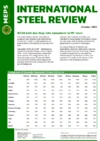Update: North American Trump tariffs suspended
President Donald Trump’s imposition of 25% import tariffs on imports from Canada and Mexico will decouple steel price movements in the United States from those of its North American neighbours.
If fully implemented, 25% tariffs from the two countries would stall exports into the United States. This would reduce demand on the Canadian and Mexican steel industries and, in the case of some steel products, create oversupply – applying downward pressure to domestic prices.
However, three days after Donald Trump announced the tariffs, their application was delayed for one month after agreements were reached with the Canadian and Mexican governments yesterday (February 3). The 10% tariffs proposed on goods from China will be implemented from today, however.
Although not a permanent settlement, the temporary reprieve for Canada and Mexico will be welcomed by steel suppliers in the two countries.
In 2024, almost 50% of steel produced in Canada was exported to the US. This amounted to six million tonnes, around 60% of which was flat products.
Mexico, meanwhile, exported 3.2m tonnes of a total steel industry output of 13.7m to the US last year. A third of this exported volume was accounted for by slabs.
MEPS’s US steel market analyst Laura Hodges believes that oversupply is a risk to the Canadian and Mexican steel markets if the proposed 25% tariffs were implemented.
In the US, MEPS’s research respondents for the monthly International Steel Review have been reporting weak demand and healthy inventories in recent months. However, a slowdown in imports is likely to apply upward pressure to steel prices.
US steel prices to rise ‘faster than expected’
Speaking ahead of Tuesday’s agreements with Canada and Mexico, Hodges said: “US steel prices will rise faster than expected over the next few months because of the 25% tariffs on Mexican and Canadian goods. When US Section 232 tariffs were announced in 2018, prices rose by over 40% in the first half of that year.
"We do not expect prices to rise as much this time around because of additional domestic capacity and lower demand but tariffs will raise US steel prices by at least 10-15% above previous forecasts for the first half of the year, assuming they remain in place."
Hodges added: “US mills are looking for reasons to lift prices following the market’s recent lows. Nucor has already raised its consumer spot price for hot rolled coil by USD25 per short ton over the last week.”
North American supply chains have become closely aligned since the United States-Mexico-Canada Agreement agreed by President Trump during his last term in office. The USMCA replaced the North America Free Trade Agreement in July 2020.
This month’s proposed imposition of tariffs – confirmed with the signing of an executive order on Saturday (February 1) evening – was made possible after the president invoked the International Emergency Economic Powers Act (IEEPA). A statement issued by the White House said that the IEEPA had been invoked in response to the “extraordinary threat posed by illegal aliens and drugs, including deadly fentanyl” from Canada and Mexico.
The possible effects of the tariffs on the two countries would be widespread, however.
The US automotive industry, which is estimated to account for 20-25% of the country’s steel consumption, would be significantly affected. S&P Global Mobility estimates that 15% of US light-vehicle sales were built in Mexico and just under 7% in Canada. However, many US-based carmakers also import Mexican raw materials and finished components – including powertrains – to manufacture their vehicles.
Inflation risk posed by tariffs
Following President Trump’s announcement on tariffs many economists warned of increased costs for both North American manufacturers and consumers. Consequently, the measures have been seen as a risk to efforts to reduce US inflation, which rose from 2.7% to 2.9% in December.
The potential for inflation was heightened by the risk of retaliatory tariffs from Canada and Mexico.
Canadian Prime Minister Justin Trudeau initially announced that tariffs worth CAD30 billion annually will be applied to US goods from February 4. Steel was not included in the measures. A further CAD125bn would be applied in 21 days. His staged approach allowed time for negotiations, however. Following negotiations with President Trump, Prime Minister Trudeau agreed to tighten border controls in return for a delay of the tariffs’ implementation.
A statement issued by Donald Trump via social media platform X on February 3), meanwhile, revealed that Mexican President Claudia Sheinbaum had agreed to deploy 10,000 troops to Mexico’s northern border to prevent the “flow of fentanyl and illegal migrants”. In response, President Trump has delayed the implementation of tariffs for a month.
A White House statement had stated that tariffs applied to Canadian, Mexican and Chinese goods would stay in place “until the crisis is alleviated” but had provided no specific benchmarks needed for them to be lifted.
President Trump has repeated his threats to impose similar tariffs on goods from the European Union. During January research of MEPS’s European Steel Review, EU research respondents expressed concerns about reduced US export opportunities amid low domestic demand. They also fear further downward price pressure from low-cost Asian-origin steel exports that could be diverted away from the US.

Source:
International Steel Review
The MEPS International Steel Review is an essential monthly publication, offering professional analysis and insight into carbon steel prices around the world.
Go to productRequest a free publication





